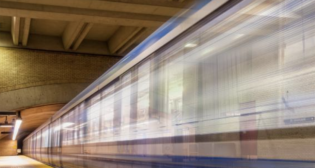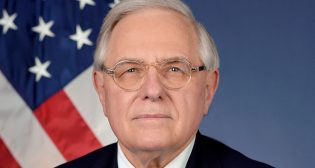
Texas Central: Amtrak to the Rescue?
Written by William C. Vantuono, Editor-in-ChiefI did a double take when an Amtrak press release with this headline hit my inbox: “Texas Central and Amtrak Seek to Explore High-Speed Rail Service Opportunities between Dallas and Houston.” Come again? A lot of people, yours truly included, thought this project died deep in the heart of Texas, probably on Calvin House’s dude ranch.
Texas Central Partners and Amtrak say they “are seeking opportunities to advance planning and analysis work associated with the proposed Dallas-Houston 200-mph high-speed rail project to further determine its viability. Amtrak has cooperated with Texas Central on various initiatives since 2016 and the two entities are currently evaluating a potential partnership to further study and potentially advance the project.” They’ve submitted applications to several federal programs “in connection with further study and design work for the potential Dallas to Houston segment, including the Consolidated Rail Infrastructure Safety and Improvements (CRISI) Corridor Identification and Development (CID), and Federal-State Partnership for Intercity Passenger Rail (FSP-National) grant programs.”
If this works, it means that the project, subject of an 11-part series “Is Texas Central Really a Railroad?” by Railway Age Contributing Editor David Peter Alan, will progress from being privately funded (which was never going to happen, because passenger rail projects globally just don’t get built that way—let’s not kid ourselves), to federally funded, which is how it should work and will work if the government ever eradicates the highway/airline mindset disease that has infected transportation since the 1950s. I’m not holding my breath.
For the first time, we hear from the man who affectionately became known as “Train Daddy” when he was president of MTA New York City Transit, running it with skill and dedication before he got sick of micromanagement by New York State’s disgraced former governor, Andrew Cuomo: Andy Byford, who returned to the United States following a successful tenure as Transport for London Commissioner and is now Amtrak’s Senior Vice President of High-Speed Rail Development Programs.
“If we are going to add more high-speed rail to this country, the Dallas to Houston Corridor is a compelling proposition and offers great potential,” said Byford, who I think herein should be named High-Speed Train Daddy. “We believe many of the country’s biggest and fastest-growing metropolitan areas, like Houston and Dallas, deserve more high-quality, high-speed intercity rail service, and we are proud to bring our experience to evaluate this potential project and explore opportunities with Texas Central so the state can meet its full transportation needs.”
Absolutely! Amen!
“The proposed approximately 240-mile route would offer a total travel time of less than 90 minutes between two of the top five major U.S. metropolitan areas and would complement future, new and improved corridor and long-distance service in the southern region,” Amtrak and Texas Central said, adding that the two have collaborated since 2016 when they entered into agreements to provide through-ticketing using the Amtrak reservation system and other support services for the planned high-speed rail line.
Texas Central Chief Executive Officer Michael Bui has resurfaced, stating: “This high-speed train, using advanced, proven [Japanese] Shinkansen technology, has the opportunity to revolutionize rail travel in the southern U.S., and we believe Amtrak could be the perfect partner to help us achieve that. We appreciate Amtrak’s continued collaboration and look forward to continuing to explore how we can partner in the development of this important project.”
Dallas Mayor Eric L. Johnson is on board, too: “Dallas is the engine of the fourth largest and fastest growing region in the nation. It is bold, innovative endeavors like this that will propel Dallas toward an even more prosperous future. A high-speed rail line would revolutionize transportation in our region, serve as a catalyst for economic growth, and enhance connectivity among Texas residents and businesses.”
Houston Mayor Sylvester Turner is jumping up and down at the southern end of the proposed system (which as originally envisioned does not connect with Metro light rail): “The collaboration between Texas Central and Amtrak is an important milestone for the City of Houston and this project. Our city is committed to advancing transportation initiatives that support economic growth and enhance quality of life for our residents. The potential partnership of these two companies will accelerate the planning and analysis necessary for the successful implementation of a modern, efficient and environmentally sustainable rail system connecting Houston and Dallas. I commend all parties involved for their dedication to this transformative project.”
Labor is cheering: “The Ironworkers strongly support the Dallas-to-Houston high-speed rail project,” said Jerry Wilson, Iron Workers District Council of Texas and the Mid South States. “Not only is it safe and green, but it will provide hundreds of highly skilled, good paying jobs for our members as we transport, erect and install the infrastructure.”
More happy-talk we in this industry already know, and have been preaching to mostly deaf ears for decades: “High-speed rail service with mostly dedicated and purpose-built rights-of-way can radically shrink trip times, achieve excellent reliability and provide significant capacity—all things that will drive ridership and help convince people to shift their trips to rail. When complete, this project is forecast to provide significant social, environmental, employment and economic benefits to the people of Texas. As an example, the project is estimated to reduce greenhouse gas emissions by more than 100,000 tons per year, saving 65 million gallons of fuel while removing 12,500 cars per day from I-45. Construction and operations of the proposed high-speed rail line would bring significant economic benefits to the region, including thousands of well-paying construction jobs and nearly 1,000 long-term, skilled operations and maintenance positions.”
If all this happy-talk is going to result in 200-mph bullet trains streaking across the Texas landscape faster than speeding bullets, the U.S. government is going to have to show us the money, for a very long time. Again, I’m not holding my breath. But I’m an optimist …



